Part Analysis
| General Data | |
| Manufacturer (OEM) | Chicony Power |
| PCB Type | Double-Sided |
| Primary Side | |
| Transient Filter | 4x Y caps, 2x X caps, 2x CM chokes, 1x MOV |
| Inrush Protection | 1x NTC Thermistor JNR15S100L (10 Ohm) & Relay |
| Bridge Rectifier(s) |
2x Diodes GBU15JL (600V, 15A @ 115°C)
|
| APFC MOSFETs |
2x Infineon IPP60R120P7 (600V, 16A @ 100°C, Rds(on): 0.120Ohm) &
1x Champion CM03X (reduce the no-load consumption) |
| APFC Boost Diode |
1x CREE C6D08065A (650V, 8A @ 155°C)
|
| Bulk Cap(s) |
1x Rubycon (450V, 680uF, 3,000h @ 105°C, MXK)
|
| Main Switchers |
2x Infineon IPA60R120P7 (600V, 16A @ 100°C, Rds(on): 0.120Ohm)
|
| APFC Controller | Infineon ICE2PCS01G |
| Resonant Controller | MPS HR100A |
| Topology |
Primary side: APFC, Half-Bridge & LLC converter
Secondary side: Synchronous Rectification & DC-DC converters |
| Secondary Side | |
| +12V MOSFETs | – |
| 5V & 3.3V | DC-DC Converters: 4x Alpha & Omega AON6144 (40V, 89A @ 100°C, Rds(on): 2.4mOhm) PWM Controller(s): ANPEC APW7159C |
| Filtering Capacitors | Electrolytic:3x Nippon Chemi-Con (2-5,000h @ 105°C, KZE) 2x Nichicon (5-6,000h @ 105°C, HV) 1x Nichicon (2-4,000h @ 105°C, HD) 2x Rubycon (6-10,000h @ 105°C, ZLH)Polymer: 11x Nippon Chemi-Con, 7x FPCAP, 10x NIC, 2x Nichicon |
| Supervisor IC | Weltrend WT7502R |
| ARM Microcontroller | Nuvoton M032EC1AE (USB connectivity & Fan control) |
| Fan Model | Snowfan YY14025M12B (140mm, 12V, 0.40A, Fluid Dynamic Bearing Fan) |
| 5VSB Circuit | |
| Rectifier |
STMicroelectronics STD4N80K5 FET(800V, 1.7A @ 100°C, Rds(on): 2.5Ohm)
Advanced Power AP6N6R5LMT-L FET (60V, 16.9A @ 70°C, Rds(on): 6.5mOhm) |
| Standby PWM Controller | OnSemiconductor NCP12400 |
| -12V Circuit | |
| Rectifier |
UTC LM7912L (-12V, 1A)
|
The PCB provides lots of space between the parts, which is suitable for airflow. The fan doesn’t have to spin fast to remove the heat from the PSU’s internals. The main transformer is small, using a unique design to cope with the unit’s max power, and the heatsinks are also small, especially on the secondary side. The build quality is high since Chicony’s production lines are good.
As in the V850i, the unit is advertised as semi-digital, but this is not the case since it uses analog controllers for all its vital functions. It only provides monitoring functions through the Nuvoton M032EC1AE MCU that it uses. Interestingly, this MCU’s target apps are gaming mice, LED controllers, and coffee makers! I am sure that Nuvoton didn’t have PSU use in its targeted apps!
We meet a half-bridge topology and an LLC resonant converter on the primary side. On the secondary side, the 12V rail is generated through a synchronous rectification scheme, and a pair of DC-DC converters generate the minor rails. All parts are of high quality, and the electrolytic caps belong to respected Japanese manufacturers.
The cooling fan uses a fluid dynamic bearing, and it is from a brand that I never encountered so far. Although its model number implies a 140mm fan, it is a bit smaller, with a 135mm diameter.
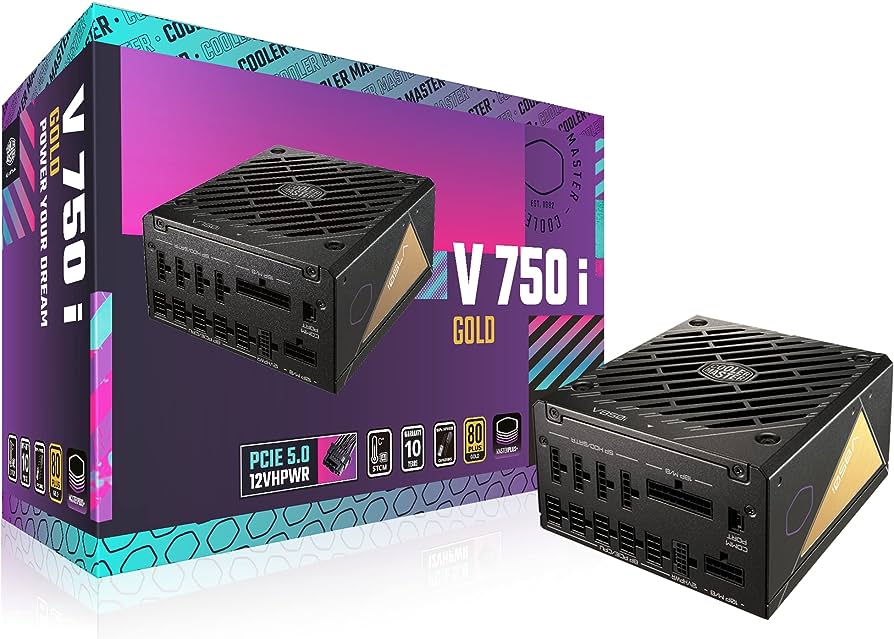
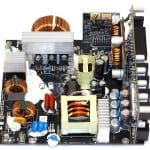
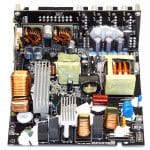
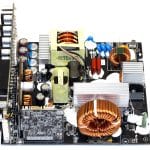
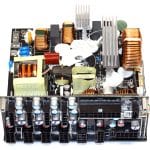
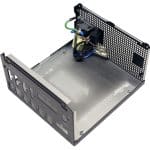
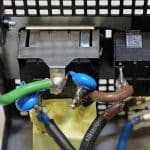
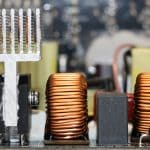
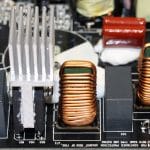
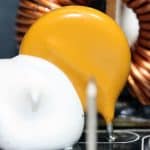
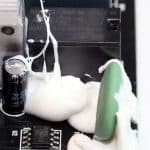
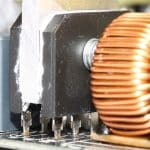

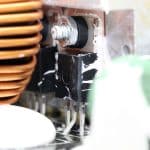
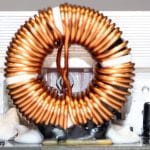
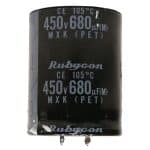

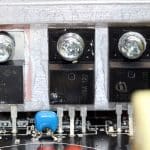
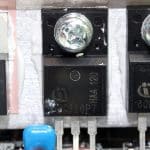
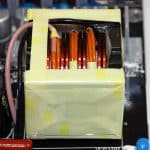


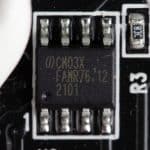
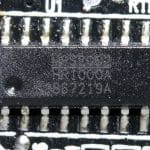
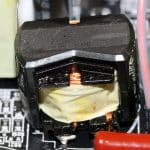
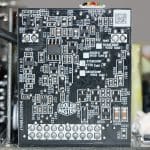
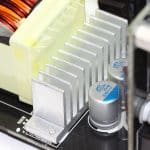
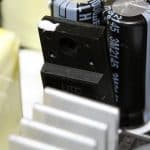
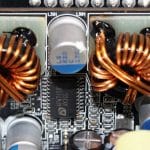
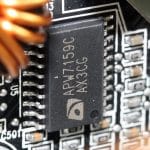
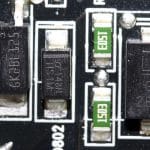
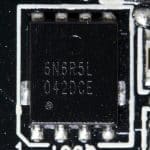
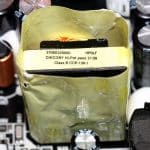
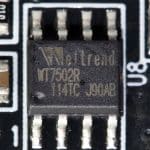
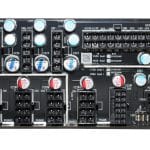
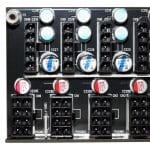
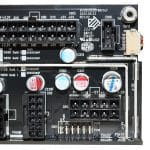
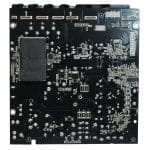

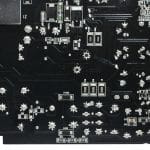


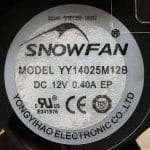


what do you think about the new ltt labs reviews where they say this PSU should never be bought?
https://www.lttlabs.com/articles/psu/cooler-master-v-sfx-gold-750-atx-3-0
First of all this is a different mode, an SFX unit, not the one that I reviewed. I also don’t want to criticize other people’s/reviewer’s work. I conduct PSU reviews for 16 years now, and I have developed my own methodologies. I use my own software, not the automated Chroma software, which is not ideal for proper PSU testing.
You can my find my methodology at Cybenetics.com if you are interested in diving more into PSUs (and not only).
With the 12+4 pin (12VHPWR) connector I get max 300W. Could I get more (e.g. 450W) with the correct “Dual 8-Pin to 12VHPWR cable”?
With that said, how can I know how much power I can actually get with a Dual 8-Pin to 12VHPWR cable out of a particular PSU? If I were to use e.g. a Seasonic FOCUS GX 750W and the Seasonic 12VHPWR Cable rated for 600W, could I actually get up to 600W (300W from both CPU/PCI-E ports)? Or would that only be possible with a FOCUS GX 1000W for example?
Sorry, if that question seems weird. It’s just that I know that a 8 pin EPS12V connector has a max power rating of 336W and a 8 pin PCIe connector has a max power rating of 150W. Because modular PSUs use the same port for both it should be possible to get 600W from 2 ports/connector without melting it. Am I understanding that correctly?
However the Seasonic 12VHPWR cable and most others use only 6 of the 8 pins? So is it still possible and safe to draw 300W from there?
Forgive my ignorance about this topic, but I wasn’t able to find a clear answer on the interwebs that I could understand.
750W PSUs are limited to 300W according to the ATX spec.
Hi Aris,
I noticed in the article on Best ATX 3.X PSU (Best ATX v3.x & PCIe 5.x Ready PSU Picks 2024 – Hardware Busters) that the v750i wasn’t listed in the 750w category. What is the reason for this despite it being better than the TT GF3 and PF3 750w on overall performance in both 115 and 230 volts AC?
Many Thanks 🙂
Hi! I am confused with this PSU. I cannot find it on Amazon. Actually, I got a kickback from the affiliate link that I used that this product is no longer available. This is why I removed it.
Thanks for the reply Aris. That’s interesting, where I am it’s currently available for just under 100usd (after conversion) so I’m thinking of buying it for a 750w build. Would it still be the best pick today (assuming it’s available)? 🙂
at 100 USD is a good choice!
These Cybenectics/80 Plus gold-rates psus are really good performance-wise. Price-peformance is even better.
What I don’t like is the noise. 23 dbA is very audible. No clue if you testers or people from cybenetics etc. have damaged hearing or are partly deaf or so, but I can clearly hear my 18 dbA rated psu from 2 meters away in a somewhat silent room. ;=)
You people state that 20 dbA or so is not audible anymore from 1 m distance, but I can cleary hear it. No, I I’m not a bat 🙂
– Does this one has any coil whine?
– Is it compatible with future 2x 8pin-to-12+4pin cables, for enhanced protection? After all besides the 12VHPWR socket, it has multiple 2x 8-pin sockets.
Greetings
if you can hear so well, then you are probably Batman 😀
I didn’t notice any coil whine during testing, but this depends on the system that you will hook the PSU
I think that by now most brands will use the new 12+4 pin socket, and not the older one.
I don’t understand it myself. Yes I can still hear frequencies up to 18 – 19 kHz and very quiet sounds (whispers, and a pin needle falling on the floor from few meters away) but I thought the test equipment at Cybenetics and 80 Plus is better than any human hearing.
So how come Seasonic states mine Titanium TX psu is “literally inaudible, at the threshhold of human hearing”, and here I can clearly hear the fans start spinning from 2 – 3 meters away at only 300 watts load?!
I know the differences between dB and dBA and that there are differnces in anechoic chambers, but I can’t have ears better than the most sensitive equipment.
It’s the same with people testing graphic cards and stating “32 dBA fan spinning is not audible anymore inside a case, from 50 cm away”, and here I can still hear it from 4 meters away.
Btw. I asked a company representative from a known psu manufacturer (you people here test their products all the time) who sells in Europe, when their updated ATX 3.1 psu with the 12V-2×6 socket will arrive, and she stated “starting from Q1 2024”.
Yes, the 12+4 pin socket is fine, the burning cable and adapters were only due to users not being attentive, not fully plugging the adapter in or bending way to much.
I will tell you one little secret, the best noise tool is the human ear, because it can go down to 0 dBA, while the best mic in the world right now, has a low limit at 6 dBA. Now if you are able to catch super low frequencies or super high ones, you have cat’s hearing!
Also 80 P doesn’t do noise testing, at all. Only Cyben does.
ps. 32 dBA is not quiet even from 1 meter away.